An easy, step-by-step whole wheat sourdough bread recipe and video that’s light and flavorful (not heavy and dense). Made with 20% whole wheat flour. Naturally leavened with active sourdough starter. Excellent for sandwiches, toast and soup.
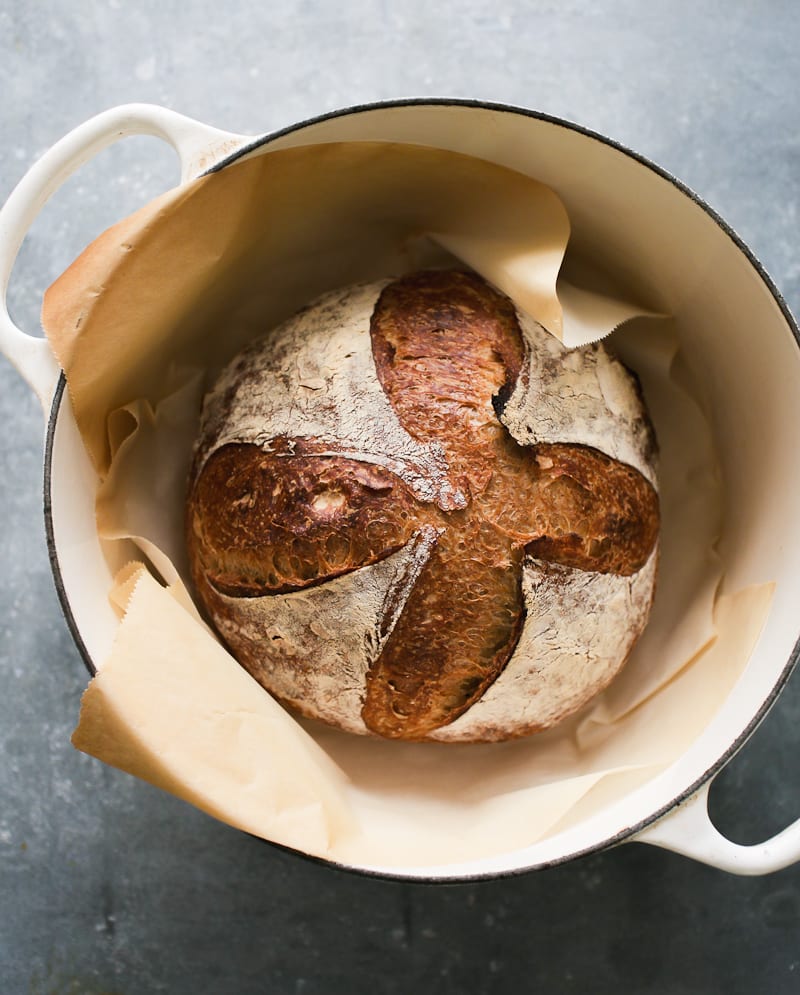
Whole grain flours are prized for their toasty, earthy flavors. Packed with plenty of fiber and nutrients, their natural complexity is a perfect match for slow-fermented sourdough bread. However, in bread baking there are rules…
You can’t just swap white flour for whole wheat flour and expect the same results (unless you like dry and dense bread). Adjustments need to be made. In this post, you’ll learn how to make exceptional whole wheat sourdough bread that’s not only light and delicious, but good for you too.
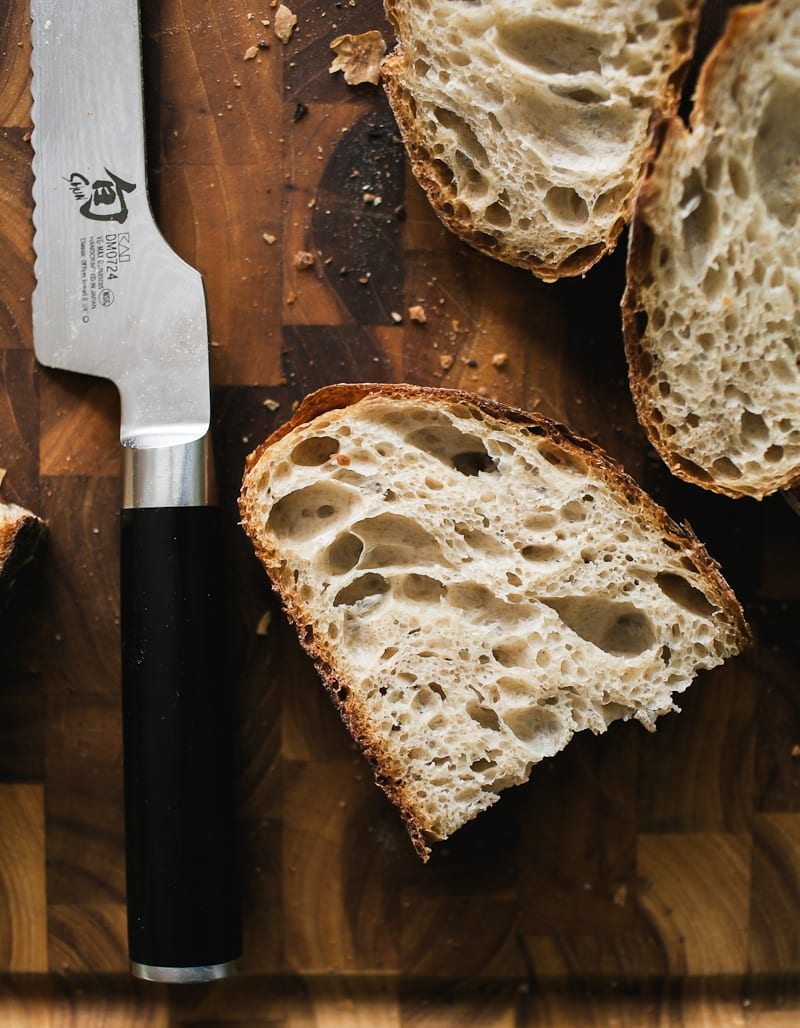
How to Make Whole Wheat Sourdough Bread
Mix The Dough
Weigh your ingredients using a scale. Mix the starter and water together in a large bowl. Add the flour and salt. Stir to combine and then squish by hand to fully incorporate the ingredients. This dough is very sticky, around 75% hydration. It’s like playing with wet mud (and it’s very satisfying). Cover the bowl and let rest for a 1 hour.
TIP: Whole wheat flour is incredibly thirsty. Because it absorbs more water than regular white flour, extending the “autolyse” or first rest period gives this dough ample time to hydrate. You’ll notice a huge difference after the full hour. The dough will be incredibly soft, and easy to stretch and fold later on.
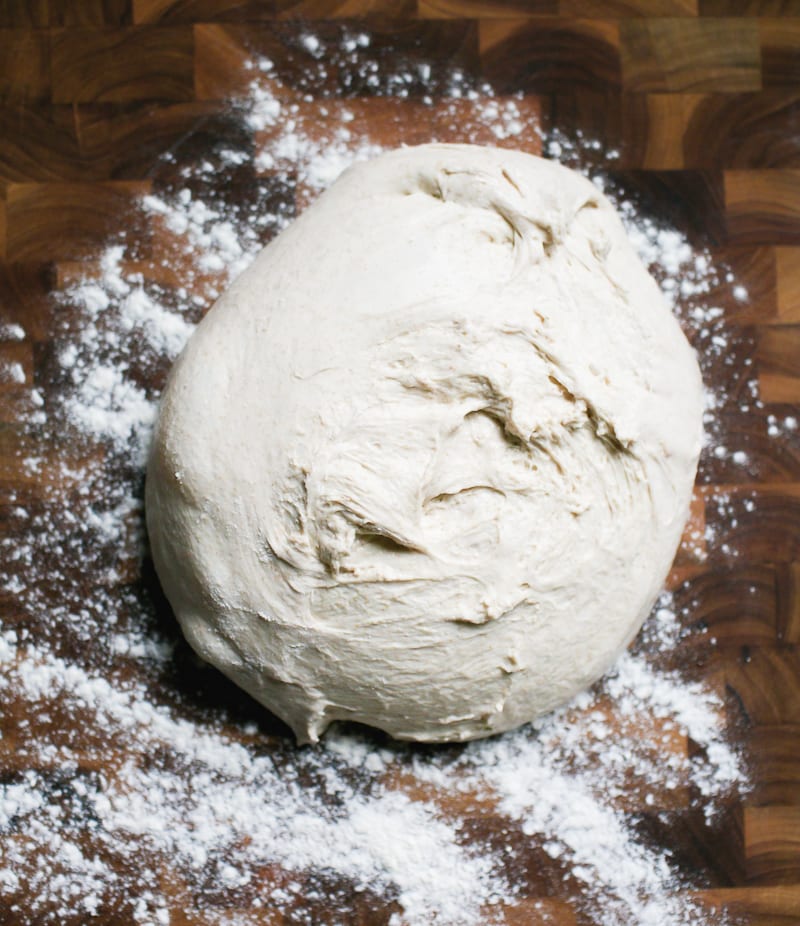
Bulk Rise with Stretch & Folds
Now, the dough needs to rise.
During this time period, you’ll stretch and fold the dough to boost the height of the bread. I like to do 4 sets spaced 30 minutes apart, resting the dough in a warm spot in between each set. The dough will become soft, pillowy and a bit stiffer by the 4th set which is what you want (don’t forget to watch my video above!).
When finished with the folds…
Cover the bowl and continue the bulk rise, untouched at 75-78 F for about for 2-3 hours. The dough is ready when it has almost doubled in size. Cover the bowl with lightly oiled wrap and chill overnight.
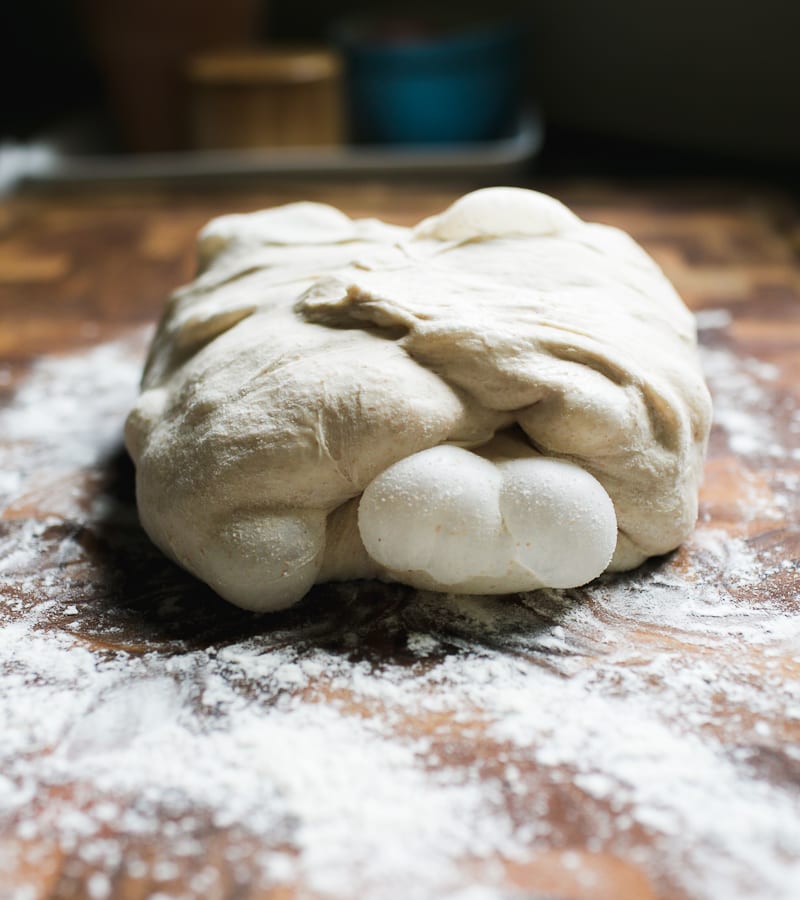
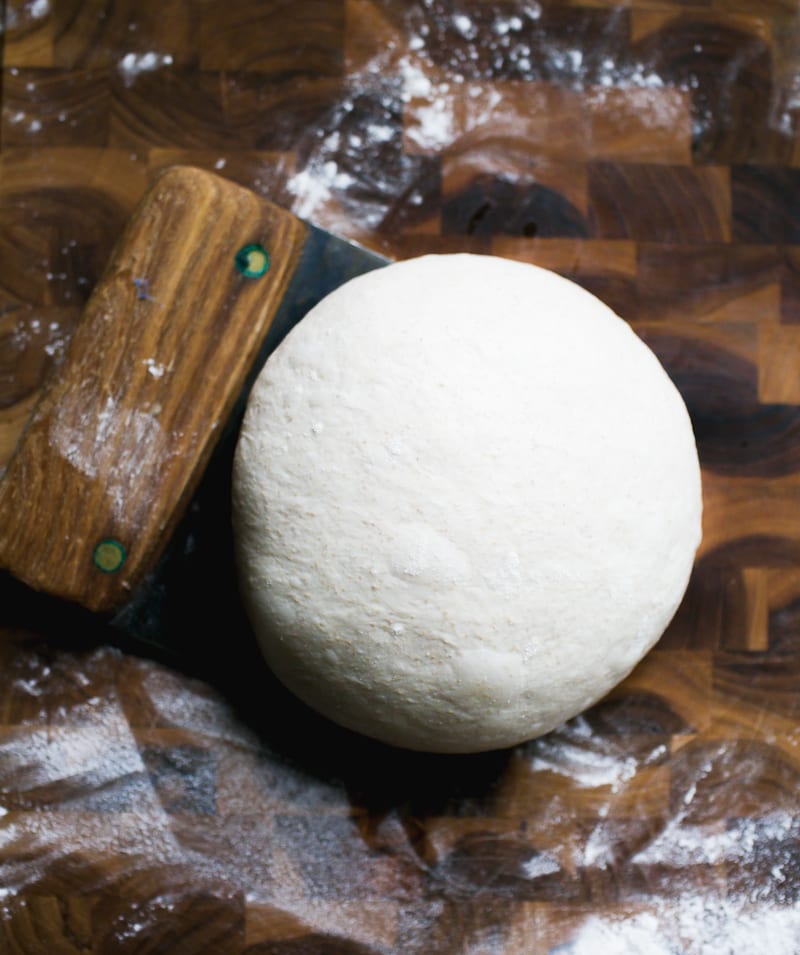
Shape The Dough
The following morning, you’re going to shape the dough twice to build extra strength. The first shaping is called a “preshape” and the second one is the “final shape.”
Preshape
Remove the cold dough onto a floured surface. Rest for 10-15 minutes to take the chill off. Shape the dough into a loose ball; cover and rest for 20-30 minutes.
Final Shape
Using a bench scraper for guidance, flip the dough over and shape it again (a little bit tighter this time). Place into the lined bowl or proofing basket seam side up. Cover the dough with the cloth overhang.
Preshaping Bread Dough: Not every dough needs a preshape. However, wet doughs like this one benefit from the extra support to holds its shape. Otherwise it might spread out a bit.
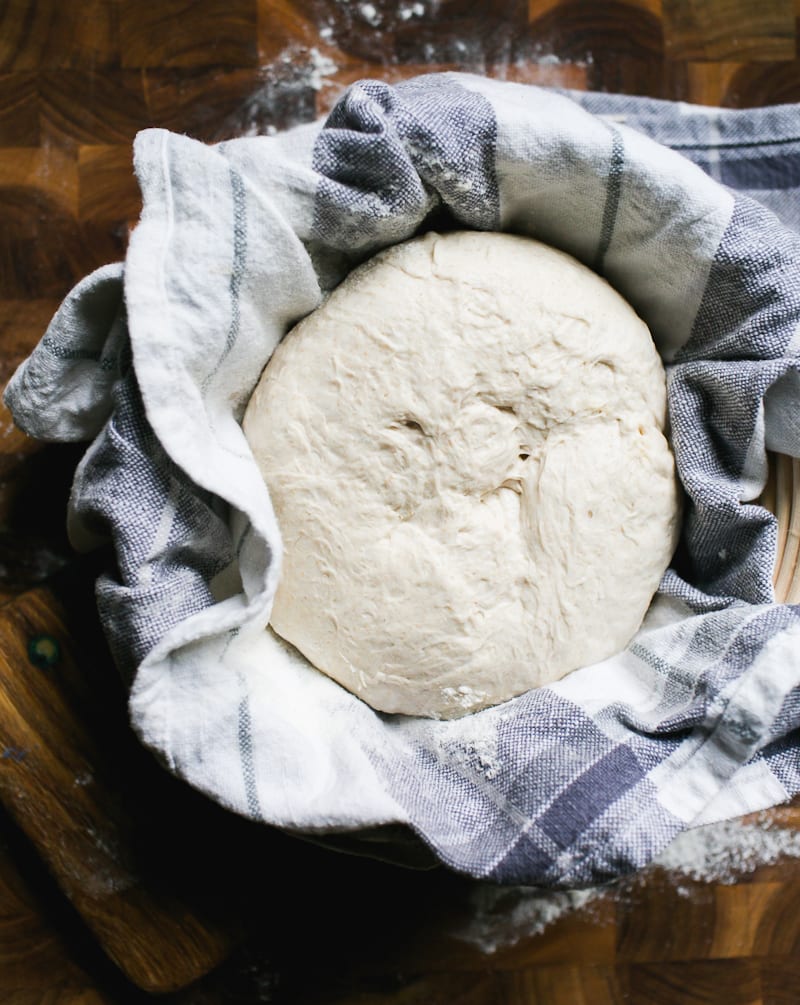
Second Rise
The dough needs to rise again.
Rest the dough in the warm spot you used earlier for about 30 minutes to 1 hour. The dough is ready when it has puffed up and looks plump. It should not be super cold prior to baking.
Preheat the oven to 450 F towards the tail end of the second rise.
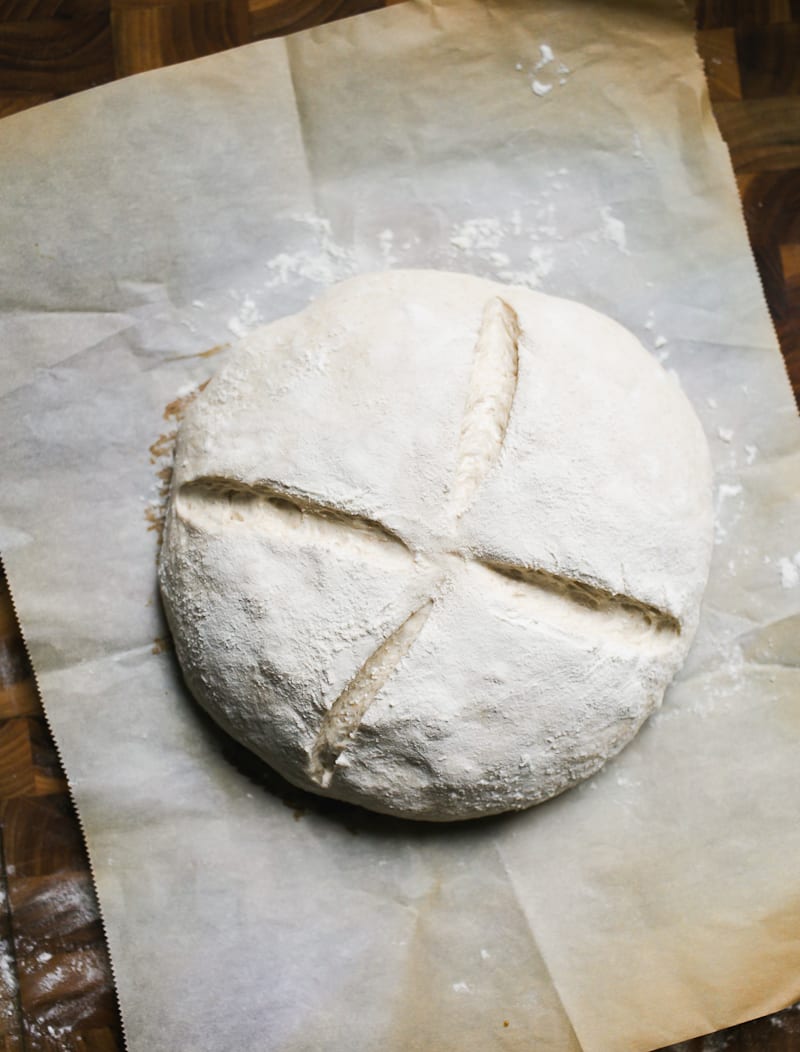
Score The Dough
Using a bread lame or a small serrated knife score the dough at 12, 3, 6 and 9 o’clock, turning the parchment paper as you go. Alternatively, you can make one long slash down the center. Do whatever you feel comfortable with.
Bake The Dough
Bake the dough in a Dutch oven (or another oven safe pot) with the lid on for 20 minutes. Remove the lid and bake for an additional 40 minutes or until golden brown. Remove from the pot. For best texture, cool on a wire rack for 1 hour before slicing
How good does this look?!
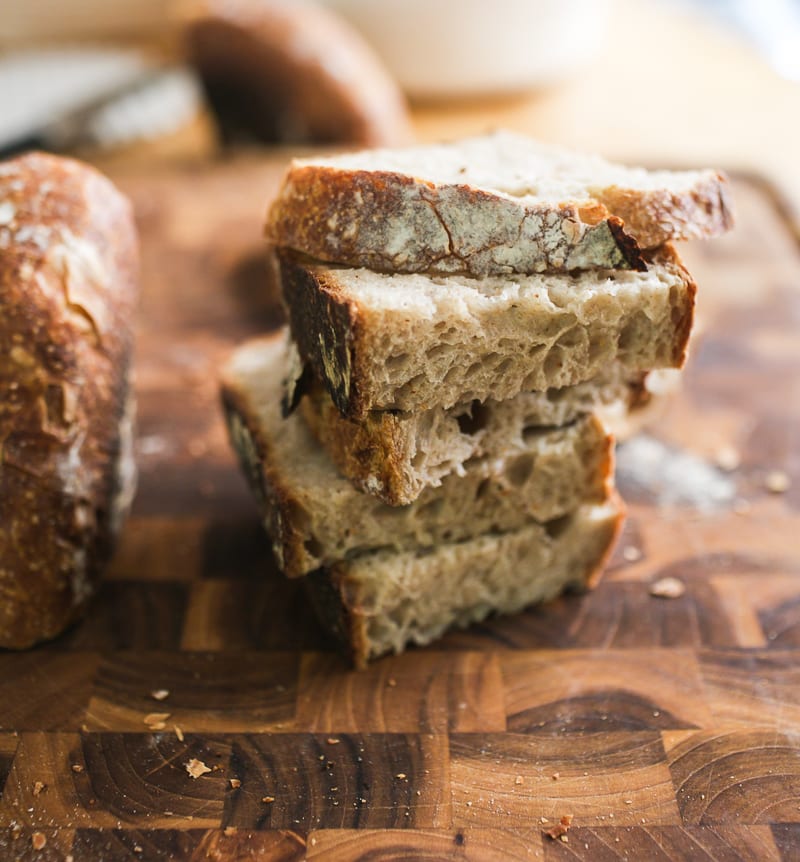
How Does it Taste?
Because this dough is made with 20% whole wheat flour, the flavor is mild and nutty with a beautifully light texture. It’s perfect for those who want the taste of whole wheat without the heaviness.
For a heartier loaf, you can increase the whole wheat up to 30% with additional water (see recipe below). However, I think this particular recipe and method is the perfect starting point. Try it and see for yourself!
Sample Baking Schedule
TIP: Whole wheat doughs tend to rise faster than white doughs, especially in warm weather. To avoid over proofed dough, I like to make this recipe in the afternoon (usually between 2-3 PM) when I know I’ll be home to incorporate the stretch and fold technique. The dough is shaped and baked the following morning.
- 2:00 PM: Mix the dough/Rest for 1 hour
- 3:00 PM: 1st Stretch and Fold
- 3:30 PM: 2nd Stretch and Fold
- 4:00 PM: 3rd Stretch and Fold
- 4:30 PM: 4th Stretch and Fold
- 5:00 PM: Bulk rise for 2-3 hrs @ 75- 78 F
- 7:00 or 8:00 PM: Cover and chill the bowl overnight
- 6:00-8:00 AM (the following morning): Shape & Bake the dough
More Sourdough Bread Recipes to Try!
- Sourdough Bread: A Beginner’s Guide
- Sourdough Focaccia Bread (soft & fluffy!)
- Easy Sourdough Sandwich Bread
- Soft Sourdough Cinnamon Rolls

Light Whole Wheat Sourdough Bread
- Yield: 1 loaf
- Category: Sourdough Bread Recipes
- Method: Oven-Baked
- Cuisine: American
- Diet: Vegan
Description
An easy recipe for whole wheat sourdough bread that’s light and flavorful (not heavy and dense). Made with 20% whole wheat flour. The dough can be made in advance and baked the following day. Fantastic for sandwiches, crostini, and morning toast with jam.
Ingredients
- 50g bubbly, active sourdough starter (100% hydration)
- 350g – 375g warm water (80–85 F)* See note below
- 400g bread flour
- 100g whole wheat flour
- 9g fine sea salt
Notes & Substitutions
* Flour is like a sponge. Depending on the brand you’re using, it might not absorb all of the water. Start with 350g of water if you’re using a low protein bread flour, less than 12.7%.
For best results, use a scale to weigh your ingredients. If using measuring cups, please aerate the flour first, lightly spoon it into the cup, and then level off the excess with the back of a knife.
Instructions
Baking Schedule
Whole whether doughs tend to rise faster than white doughs, especially in warm weather. To avoid over proofed dough, I like to start mixing in the afternoon (usually between 2-3 PM) when I know I’ll be home to stretch and fold the dough. Please adjust your rise times based on temperature.
Make the Dough
Combine the sourdough starter and water in a large bowl. Add the flour and salt. Mix with a fork and then finish by hand to fully incorporate the flour. It will feel very wet and sticky. Cover with a damp towel or wrap and let rest for 1 hour on your countertop, returning to the bowl after the first 30 minutes to work the dough into a rough ball.
Bulk Rise with Stretch and Folds
After the dough has rested for 1 hour, do your first fold.
Gather a portion of the dough, stretch it upward, and fold it over toward the center of the bowl. Give the bowl a 1/4 turn and repeat 3 more times, stretch and folding the dough to come full circle around the bowl (4 folds = 1 set). If the dough still feels slack after the 1st set, do an additional 4 folds around the bowl to tighten the dough.
For best results, do 4 sets total spaced 30 minutes apart resting the covered dough in a warm spot in between each set (see tip below). Notice how the dough will tighten after the 4th set. See video for technique.
When finished with the folds, cover the bowl and continue the bulk rise (untouched) at 75-78 F for about for 2-3 hours. The dough is ready when it has almost doubled in size. Wrap and chill the whole bowl overnight; the dough will continue to rise only slightly in the fridge when the dough is warm.
How to Create Warm Spot for Bread Dough: Preheat your home oven to the lowest setting for 30- 45 seconds and then shut it off. Place the covered bowl of dough inside to bulk up. The temperature should be 75-78 F and no higher than 80 F. Use an oven thermometer (and common sense) to keep track of the temperature. Dough that is too warm will become wet, sticky, and a tricky to work with. Alternatively, I highly recommend using a proofing box.
Shape the Dough
The following morning, make sure the dough has doubled in size. If not, give it more time to bulk up, if needed. This is important to build strength.
Line a small bowl (or proofing basket) with a cotton or linen cloth. Sprinkle with flour. You’re going to shape the dough twice to build extra strength.
Preshape
Remove the cold dough onto a floured surface. Let rest for 10-15 minutes to take some of the chill off. Shape the dough into a loose ball using the envelope technique. Starting at the top of the dough, stretch and fold it over toward the center. Then stretch and fold the bottom of the dough toward the center. Repeat on the left side…and then the right side. Using a bench scraper, scoop up the dough and flip it over so the smooth side is facing up. Cover and rest for 20-30 minutes.
Final Shape
After the dough has rested, flip it over again (the smooth side should be facing down now). Shape it again following the steps above. Flip it back over. With floured hands, gently cup the dough and pull it toward you in a circular motion to tighten its shape. Place the dough into the lined bowl or proofing basket seam side up. Cover with the cloth overhang.
Second Rise
Rest in the warm spot you used earlier for 30 minutes to 1 hour. The dough is ready when it looks puffy and has risen slightly, but has not yet doubled in size. The dough should not be very cold prior to baking.
Preheat your oven to 450 towards the tail end of the second rise.
Cut a sheet of non-stick parchment paper to fit the size of your baking pot, leaving enough excess around the sides to remove the bread.
Score the Dough
Place the parchment over the dough and invert the bowl to release. Sprinkle the dough with flour and gently rub the surface with your hands. Using the tip of a bread lame, small, serrated knife or a razor blade, make four shallow 4-inch long cuts at 3, 6, 9, and 12 o’clock around the dough. Use the parchment paper to transfer the dough to a Dutch oven (or another oven safe pot with lid).
Bake the Dough
Bake the dough on the center rack for 20 minutes, covered. Remove the lid, and continue to bake for 40 minutes and golden brown.
When finished, transfer to a wire rack. Cool for 1 hour before slicing, for best texture.
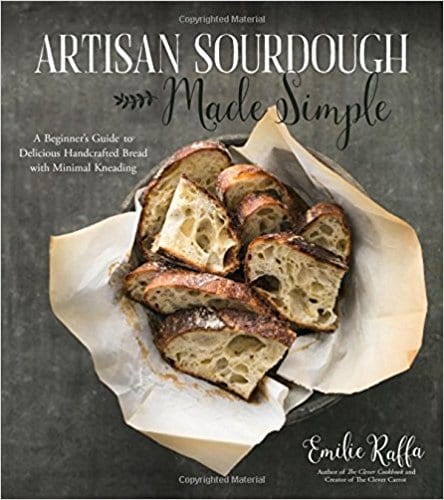


Comments
Jeroen says
Hi,
I have made this twice now and thanks to the clear explanation have enjoyed a tasty own baked sour dough bread both times.
Now ready to experiment.
Can the % of whole wheat be 25 or 30% iso of 20%?
Jeroen
Kimberly-Dawn Falk says
I love this recipe and use it most weeks I bake. I sometimes reduce the size of my bread so I change the baking time in the oven. I do 20 min with lid on and 20 minutes with lid off and then check, and then my loaves never burn.
Lori says
This is one of the better tasting and perfect crumb and crunch sourdoughs I’ve tried yet! I must admit, some of the instructions were confusing to me, ie the doubling after resting 1 hr and shaping, then chilling with only a slight rise to then seeing it should double? Also, as per the video, I heated my oven but did not heat the pan, as Emily showed. I didn’t get a high rise on the 20 min lid on bake but it did rise sufficiently to have beautiful crumb with lots of perfect whole and texture. Reached temp with 7 min’s left to bake and it was perfect (33 min’s)! I am not complaining after tasting it and I know I’ll be able to do this recipe in my sleep as many times as I anticipate baking it. It’s really so good. Thank you, Emilie!
Shirley Tipton says
This recipe never fails! Today’s loaf is made with extra coarse whole wheat giving us a rustic delight. Super oven spring!!
Michelle says
I love this bread. Made it a few times with 400:100 ratio of white to wholewheat flour, but this time took the chance of using 350:150 ratio. I changed nothing else. Still yummy!
Thanks Emelie!
Clem says
Is it supposed to almost double from the moment it’s mixed or from the last set of stretch and folds?
Mallory says
Last set of stretch and folds!
Mary says
I have a starter from a friend that says to use potato flakes, sugar and water to feed the starter. I really wanted to use flour and I prefer whole wheat flour. Is there a way to make sour dough bread with these ingredients? (My friend makes a sweet bread with hers). I am a beginner.
Gloria says
This recipe gave me my most successful sourdough bread so far! Thanks!!
Macy says
Soooo goood! My first time making sourdough and I am never going back. Something came up and I wasn’t able to follow the times exactly according to the recipe and it still came out great.
Gayle Yee says
Can I substitute rye for the whole wheat for a light rye bread , keeping all else constant ?
Gayle Yee says
I tried with swapping out the WW for rye, and it is beautiful ! Exact same directions with time to rise, the stretch and fold etc.
Sara Greene says
Hi Emilie,
This seems like a great recipe for my schedule, etc. however, I struggled with the post-fridge part. Even after leaving the dough out for 2.5 hours (rest, preshape, final shape/rise in banneton – warmed in multiple blankets and towels), the dough was still cold. I baked it for fear of overproofing. How can I get it to warm up properly? I can’t use the oven because I need to preheat it for baking, and I don’t have a proof box.
El says
Best loaf yet! Easy to follow instructions.
Ashly Pacciorini says
I used this recipe and it was the only recipe that has worked for me so far! Highly recommend!